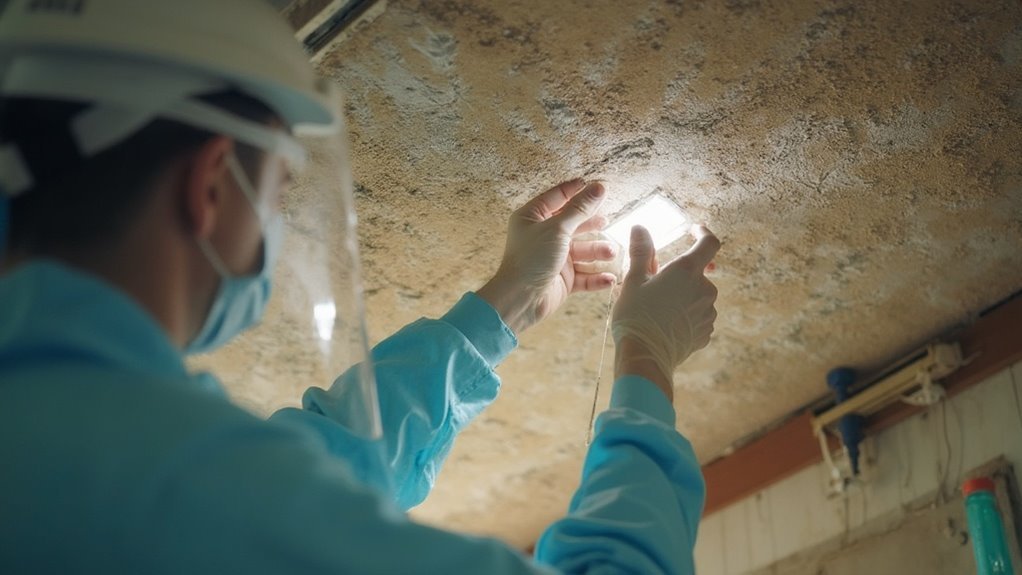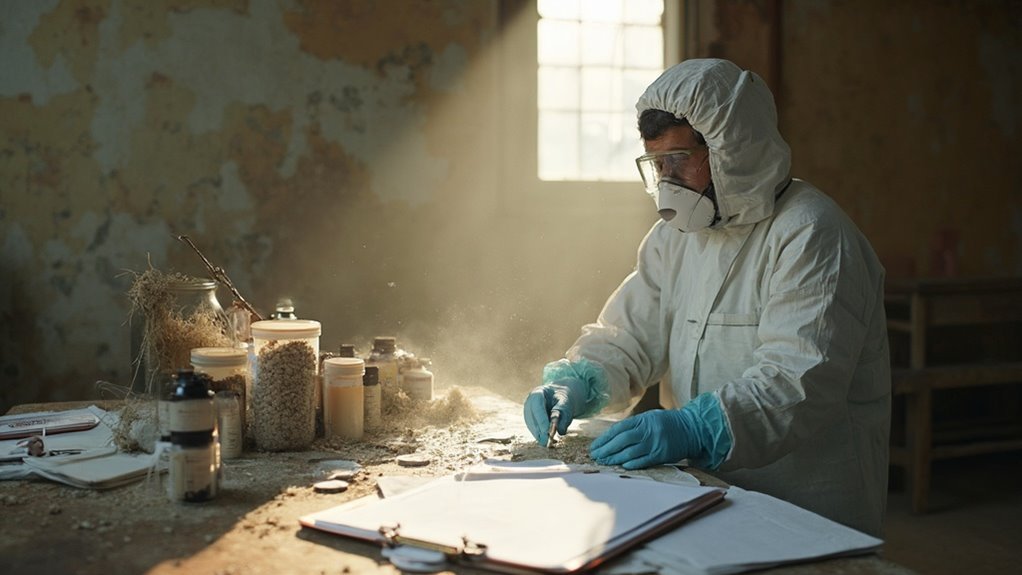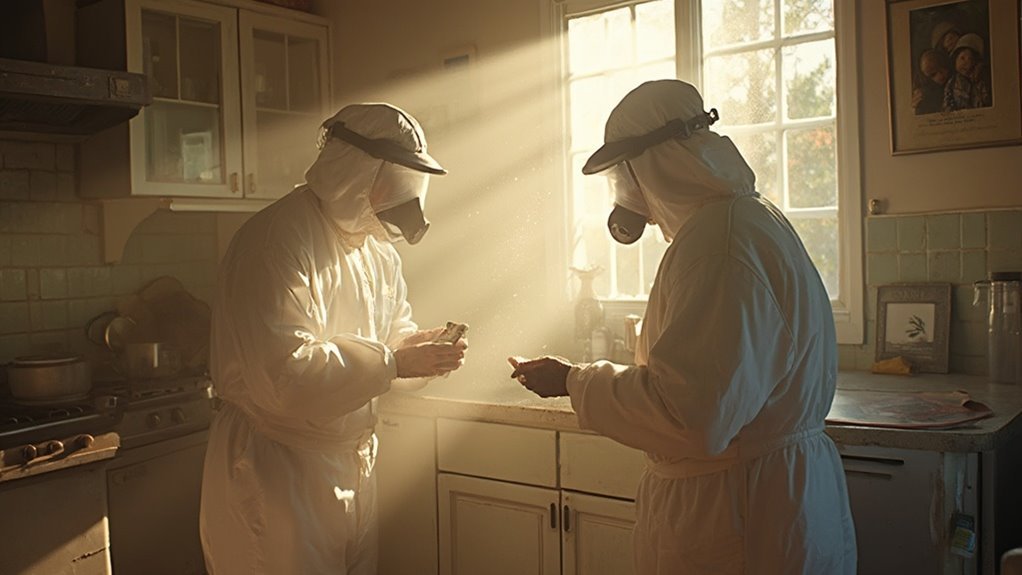Professional asbestos testing is essential for protecting your health and home from dangerous fibers that can linger unseen. When you hire certified inspectors, they accurately identify asbestos hazards using specialized equipment and safety protocols. This testing is particularly important before renovations or if you've noticed damage, as disturbing materials can release harmful particles. By ensuring compliance with legal regulations, you likewise prevent potential fines associated with improper handling. Proactive testing minimizes your risk of serious health issues, such as lung diseases, caused by asbestos exposure. Understanding this process can help you make well-informed choices for your home's safety.
Understanding Asbestos Risks

Understanding the risks associated with asbestos is crucial for your health and safety. Asbestos comprises various types, each posing significant health risks when fibers become airborne and are inhaled. Once these microscopic fibers enter your lungs, they can remain lodged deep within lung tissue for years, leading to serious diseases such as asbestosis, mesothelioma, and lung cancer. The inhalation of asbestos fibers causes lung tissue damage, leading to scarring and inflammation.
Health symptoms related to asbestos exposure often take a long time to develop, typically manifesting 15 to 50 years after initial exposure. Even minimal exposure can result in severe health issues, as the fibers cause inflammation and scarring of lung tissue. This damage can impair your lungs and heart, reducing their ability to supply oxygen to your body effectively.
It's critical to recognize that no level of asbestos exposure is considered safe. If you suspect that your home may contain asbestos-containing materials—like insulation, mastic tiles, or acoustic ceiling tiles—it's crucial to address the issue promptly. Understanding these risks empowers you to make informed choices about renovations and safety measures, ultimately protecting your health and that of your loved ones.
Importance of Professional Testing
When it comes to managing the risks associated with asbestos in your home, professional testing plays a vital role in guaranteeing safety and compliance. Many people hold asbestos myths and testing misconceptions that can lead to dangerous oversights. For instance, untrained individuals often miss hidden hazards, but certified professionals know precisely where to look and utilize specialized equipment for accurate identification.
Moreover, professional inspectors follow strict safety protocols to minimize risks during testing. They wear protective gear to prevent exposure and make certain that the process doesn't inadvertently release hazardous fibers into the air. This adherence to safety measures is essential, as amateur testing can worsen contamination risks.
Furthermore, you must consider legal compliance. Professional testing is often mandated by law, especially before any renovation or demolition work. By obtaining accurate assessments, you avoid potential fines and legal issues, safeguarding your investments. Additionally, the use of strict protocols ensures that samples are collected safely, further enhancing the reliability of the results.
Ultimately, professional asbestos testing not only preserves property values but also protects occupants from long-term health risks. By addressing issues early, you gain peace of mind, guaranteeing a safe and healthy living or working environment.
Steps in Asbestos Testing

When it comes to asbestos testing, you'll start with a thorough visual inspection to identify potential hazards in your home. Next, certified professionals will carefully collect samples using specific methods to guarantee safety and accuracy. Finally, these samples undergo rigorous laboratory analysis to determine the presence and concentration of asbestos fibers.
Visual Inspection Process
A thorough visual inspection is critical in the asbestos testing process, as it helps identify potential asbestos-containing materials (ACMs) and assess their condition. You'll begin by reviewing historical data and interviewing occupants to pinpoint areas where ACMs may exist. Next, you'll conduct an in-depth visual inspection of all accessible spaces, focusing on various materials like flooring, ceiling tiles, and pipe insulation.
During the inspection, look for any signs of damage or degradation, as these can indicate a risk of asbestos fiber release. Document your findings systematically to inform a detailed risk assessment. The objective is to establish the extent of the work needed before any asbestos abatement begins and to monitor progress throughout the project.
A well-executed visual inspection is crucial for verifying cleanliness once the removal process is complete. This guarantees that no visible residue, dust, or debris remains, improving the chances of passing final air testing for re-occupancy. Ultimately, utilizing professional inspectors with the right training and experience boosts the accuracy of asbestos identification and compliance with safety regulations.
Sample Collection Methods
Effective sample collection is vital for accurately evaluating potential asbestos exposure in a building. To begin, seal off the testing area to prevent contamination and don protective gear, including a NIOSH-approved half-face P100 respirator. Limit your time in this area to reduce exposure to potential asbestos fibers.
Utilize appropriate testing techniques tailored to various materials. For drywall and plaster, sample both layers with a clean knife, placing them in a Ziploc bag. When sampling floor tiles, include both the tile and any mastic, ensuring to gather scrapings if possible. For vermiculite, use a flat-bottomed scoop to collect the bottom half-inch from three different locations.
Carefully collect samples to prevent dust release. Seal each sample in a Ziploc bag, wipe the outside with a damp cloth, and label clearly with the material type and location. Fill out a Chain of Custody form to maintain sample integrity. Finally, submit your samples to a certified laboratory for thorough analysis. By following these steps meticulously, you improve the reliability of your asbestos testing and protect your health and home effectively.
Laboratory Analysis Techniques
Laboratory analysis techniques play a crucial role in accurately identifying asbestos in collected samples. The process begins with sample preparation, where samples are opened in airtight containers under a particle hood equipped with negative pressure and HEPA filters to guarantee safety. Initially, you'll use stereomicroscopy to magnify the material, identifying any potential fibers. Various materials require specific preparations, such as scraping or crushing joint compounds.
Once the initial examination is complete, you can employ microscopy techniques. Polarised light microscopy (PLM) is critical for identifying asbestos fibers, utilizing refractive index liquids and filters to observe key properties like morphology and color. Dispersion staining may additionally be used to differentiate asbestos types further. For a more detailed analysis, Transmission Electron Microscopy (TEM) can provide additional insights.
Throughout this process, quality control measures guarantee accurate results. Analysts limit their workload to a maximum of 60 samples per day to maintain precision. By following these rigorous laboratory analysis techniques, you can confidently identify asbestos and protect your health and home from its harmful effects.
Statistics and Health Impacts
Each day in the United States, at least 30 individuals lose their lives to illnesses caused by asbestos exposure, underscoring the serious health risks associated with this hazardous material. Asbestos statistics reveal that between 2-10% of those exposed will develop related diseases, primarily lung ailments. In fact, 80-90% of asbestos-related diseases manifest as lung diseases, including asbestosis, lung cancer, and mesothelioma.
The health impacts of asbestos exposure are profound and can take decades to surface, typically appearing 20-50 years after initial exposure. Symptoms such as cough, shortness of breath, and chest pain often signal irreversible lung damage. Additionally, if you smoke and have been exposed to asbestos, your risk for lung cancer greatly increases, creating a dangerous combination.
From 1940 to 1980, an estimated 27 million American workers faced asbestos exposure, and today, about 1.3 million still encounter it in their workplaces. With 2,500 to 3,000 new mesothelioma cases diagnosed annually, understanding these risks is critical. By recognizing the statistics and health impacts associated with asbestos, you can take proactive steps to protect your health and your home.
Homeowner Considerations

As a homeowner, understanding when to test for asbestos is vital, especially if you're planning renovations or notice damage in building materials. Disturbing these materials can release harmful fibers, so prioritizing professional assistance for testing and removal is important. By taking these precautions, you protect not only your health but likewise comply with legal regulations surrounding asbestos.
Testing Recommendations Overview
If you're considering renovations or notice damage in your home, it's vital to check for asbestos, especially in older properties. The EPA's testing guidelines recommend conducting an asbestos risk assessment if you find damaged materials, such as drywall or insulation, or plan to disturb them during renovations. Even when the materials appear undamaged, testing is necessary if future activities could pose a risk of disturbance.
Since asbestos fibers are invisible to the naked eye, professional testing is critical for identifying their presence. Only certified professionals should carry out this testing to guarantee accurate results and your safety. They will inspect high-risk areas, take samples, and send them for laboratory analysis, thereby following industry best practices.
Remember that the age of your home and the condition of any asbestos-containing materials greatly influence how often you should test. Changes in building usage, occupancy patterns, or legislation may likewise affect your testing frequency. By adhering to these testing recommendations, you can effectively safeguard your health and comply with regulations while maintaining your home.
Renovation Precautions Importance
Understanding the risks associated with asbestos is imperative when planning renovations, as improper handling can lead to serious health hazards. Before you start any project, learn your home's history, including its construction date and past remodels. This knowledge can help you identify potential asbestos sources, such as insulation, vinyl tiles, and drywall patching.
Renovation safety should be your top priority. Always wear proper safety equipment, including goggles, gloves, full-coverage clothing, and a face mask. Avoid disturbing any materials that may contain asbestos, as this can release harmful fibers into the air. If you suspect asbestos is present, consider professional laboratory testing to confirm its presence and quantity.
It's critical to understand and comply with local and federal asbestos regulations. When hiring professionals for asbestos removal, verify they are licensed and certified, and hire separate companies for inspection and removal to avoid conflicts of interest. Proper disposal of asbestos-containing materials is indispensable, so follow all regulations to protect your health and home. By taking these renovation precautions seriously, you can minimize risks and guarantee a safer living environment.
Professional Assistance Necessity
Many homeowners underestimate the complexity of asbestos testing and the potential hazards it poses. Asbestos isn't always visible, often lurking in materials like insulation and tiles. Professional inspectors possess the necessary training and equipment to accurately identify these hidden dangers. They guarantee compliance with asbestos regulations, which is essential to avoid legal implications that can arise from improper handling or testing.
When you hire a professional, you're not just getting a service; you're gaining access to detailed reports and tailored recommendations for remediation or removal. Their expertise minimizes risks associated with asbestos exposure, employing strict safety protocols during testing to protect your health and home. Remember, there's no safe level of asbestos exposure, and any amount can pose significant health risks.
Prevention and Safety Measures
When tackling asbestos hazards, adopting effective prevention and safety measures is vital for protecting both health and home. Start by promoting asbestos awareness; avoid disturbing materials that might contain asbestos, such as insulation, flooring, and popcorn ceilings. Never scratch, sand, or drill these items, as this can release harmful fibers into the air.
When handling materials, always prioritize safe handling practices. Keep asbestos levels low by using wet cleaning methods and HEPA vacuums, especially on windy days when windows should remain closed. Prior to any work, shut down HVAC units and seal vents to prevent fiber dispersion.
For those involved in any form of renovation, professional testing is imperative. Have your home tested for asbestos to assess any risks before beginning any projects. If sampling is necessary, make certain it's done correctly to minimize health hazards. Always wet the materials before sampling to further reduce the release of fibers.
Lastly, wear appropriate personal protective equipment and follow decontamination procedures to limit exposure. By implementing these measures, you can greatly decrease the risks associated with asbestos and safeguard your environment.
Choosing the Right Professionals

Choosing the right professionals for asbestos testing is crucial to guaranteeing your home remains safe and healthy. Start by verifying that the inspectors you consider meet certification standards, having completed federal or state-approved training. Request proof of accreditation for each tester, and in the UK, look for companies with UKAS accreditation to ISO/IEC 17020, confirming their technical competence.
Check inspector qualifications, making certain they hold the P402 qualification as a minimum. A proven track record is significant; examine past performance, safety violations, and any legal actions against the firm. Seek references and reviews from previous clients to gauge their reliability. Moreover, verify the company complies with relevant laws and regulations.
The inspection process should include a complete visual examination, careful sample collection, and laboratory analysis. Inspectors must provide a written evaluation detailing damage and recommendations for correction. They should furthermore follow strict safety protocols, using protective gear, sealing work areas, and guaranteeing proper cleanup. By prioritizing these factors, you can choose the right professionals to protect your health and home effectively.
Frequently Asked Questions
How Long Does Professional Asbestos Testing Take?
Professional asbestos testing typically takes 3 to 10 days, depending on the size of the property and testing methods used. Asbestos sampling and laboratory analysis are essential steps for accurate identification and safety recommendations.
What Are the Costs Associated With Asbestos Testing?
Asbestos testing costs typically range from $231 to $778, depending on factors like property size and location. Testing service fees vary based on the type of testing required, so always get a detailed estimate.
Can I Test for Asbestos Myself?
You can test for asbestos yourself using DIY asbestos kits, but these methods often lack accuracy and may miss harmful fibers. It's safer and more reliable to consult professionals who utilize advanced asbestos testing methods for accurate results.
What Should I Do if I Find Asbestos?
If you find frightening fibers, don't disturb the material. Guarantee you minimize asbestos exposure by hiring professionals for safe removal. Protect your health by isolating the area until trained specialists can handle it effectively.
How Often Should I Have My Home Tested for Asbestos?
You should schedule asbestos testing every 12 months, especially before renovations or if materials change. Following these testing recommendations guarantees you stay informed about potential risks and maintain a safer environment in your home.
